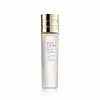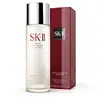Estée Lauder Micro Essence Aquaceutical™ Mist Versus SK-II Facial Treatment Essence (Pitera Essence)
What's inside
What's inside
 Key Ingredients
Key Ingredients

No key ingredients
 Benefits
Benefits

 Concerns
Concerns

No concerns
 Ingredients Side-by-side
Ingredients Side-by-side

Water
Skin ConditioningPropanediol
SolventButylene Glycol
HumectantSucrose
HumectantTrehalose
HumectantBetaine
HumectantAcetyl Glutamine
Skin ConditioningCitrus Medica Vulgaris Fruit Extract
AntioxidantLens Esculenta Fruit Extract
Skin ConditioningPyrus Malus Fruit Extract
Skin ConditioningRosmarinus Officinalis Leaf Extract
AntimicrobialArtemia Extract
Skin ConditioningAnthemis Nobilis Flower Extract
MaskingAcetyl Hexapeptide-8
HumectantGlycerin
HumectantBifida Ferment Lysate
Skin ConditioningLactobacillus Ferment
Skin ConditioningCaffeine
Skin ConditioningSodium Lactate
BufferingSodium Hyaluronate
HumectantDipotassium Glycyrrhizate
HumectantLecithin
EmollientSodium PCA
HumectantCaprylyl Glycol
EmollientPPG-5-Ceteth-20
EmulsifyingTromethamine
BufferingCitric Acid
BufferingSodium Benzoate
MaskingDisodium EDTA
Sodium Citrate
BufferingPotassium Sorbate
PreservativePhenoxyethanol
PreservativeWater, Propanediol, Butylene Glycol, Sucrose, Trehalose, Betaine, Acetyl Glutamine, Citrus Medica Vulgaris Fruit Extract, Lens Esculenta Fruit Extract, Pyrus Malus Fruit Extract, Rosmarinus Officinalis Leaf Extract, Artemia Extract, Anthemis Nobilis Flower Extract, Acetyl Hexapeptide-8, Glycerin, Bifida Ferment Lysate, Lactobacillus Ferment, Caffeine, Sodium Lactate, Sodium Hyaluronate, Dipotassium Glycyrrhizate, Lecithin, Sodium PCA, Caprylyl Glycol, PPG-5-Ceteth-20, Tromethamine, Citric Acid, Sodium Benzoate, Disodium EDTA, Sodium Citrate, Potassium Sorbate, Phenoxyethanol
 Reviews
Reviews

Ingredients Explained
These ingredients are found in both products.
Ingredients higher up in an ingredient list are typically present in a larger amount.
Butylene Glycol (or BG) is used within cosmetic products for a few different reasons:
Overall, Butylene Glycol is a safe and well-rounded ingredient that works well with other ingredients.
Though this ingredient works well with most skin types, some people with sensitive skin may experience a reaction such as allergic rashes, closed comedones, or itchiness.
Learn more about Butylene GlycolSodium Benzoate is a preservative. It's used in both cosmetic and food products to inhibit the growth of mold and bacteria. It is typically produced synthetically.
Both the US FDA and EU Health Committee have approved the use of sodium benzoate. In the US, levels of 0.1% (of the total product) are allowed.
Sodium benzoate works as a preservative by inhibiting the growth of bacteria inside of cells. It prevents the cell from fermenting a type of sugar using an enzyme called phosphofructokinase.
It is the salt of benzoic acid. Foods containing sodium benzoate include soda, salad dressings, condiments, fruit juices, wines, and snack foods.
Studies for using ascorbic acid and sodium benzoate in cosmetics are lacking, especially in skincare routines with multiple steps.
We always recommend speaking with a professional, such as a dermatologist, if you have any concerns.
Learn more about Sodium BenzoateWater. It's the most common cosmetic ingredient of all. You'll usually see it at the top of ingredient lists, meaning that it makes up the largest part of the product.
So why is it so popular? Water most often acts as a solvent - this means that it helps dissolve other ingredients into the formulation.
You'll also recognize water as that liquid we all need to stay alive. If you see this, drink a glass of water. Stay hydrated!
Learn more about Water